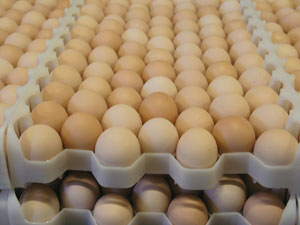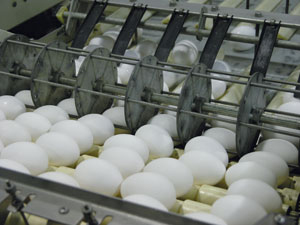
Trends in Egg Grading
By by Paul Buisman Product manager MOBA b.v. Barneveld The Netherlands
Features New Technology ProductionFurther automation and software features
Further automation and software features will dominate the future
egg grader market while service makes the difference

|
| Technology for shell grading equipment is changing rapidly to meet food safety demands. |
After a constant race for more capacity and functionality, modern egg graders are now coming to a point where food technology is gradually being introduced. Technology that is well known in other industries (e.g., the meat industry) was for several reasons not yet applicable in shell egg grading equipment. With the increasing demands for food safety, this is changing rapidly.
Together with food technology, other means to improve consumer safety are becoming more important. Reliable traceability systems that are accurate on the egg even in machinery that processes more than a million eggs per day is within reach. Last but not least, the overall quality awareness makes that more and more critical that handling be done by dedicated equipment, reducing risks of cross contamination and subsequently ensuring a controlled grading and packing trajectory until shipment from the egg packing station, eliminating chances for human errors.
Introduction
It is a clear trend that egg grading is a business of ongoing consolidation. The number of egg grading corporations as well as the number of physical packing stations is dramatically decreasing in the western world. In many European countries, the number of egg packing stations is only between 10 per cent and 20 per cent of what it was 15 years ago. It is all the result of relatively low egg prices in a world of continuous inflation. Margins on eggs are getting smaller by the day and one of the ways to compensate this is to simply process more eggs.
For a layman it might seem that for exactly these reasons, egg-grading equipment is just getting bigger in its capacity, but when one looks in more detail into this market, remarkable and interesting changes are taking place right now!
Market changes and requirements
Product diversification: For a certain part of the world (so called new markets) the just produce more eggs requirement is still valid. One can think of countries where labour is still relatively cheap but the need for high-speed, high-quality equipment is quickly rising. Where the rest of the world is a saturated replacement market, these emerging markets like Russia and China are making huge steps in implementing brand new high-capacity equipment.
In many of the saturated markets, another clear trend is product diversification. More specialized products on the shelf of the supermarket create possibilities like branding of certain eggs. Special eggs, appealing to consumer health, food safety and animal welfare, together with marketing through a wide variety of nice egg packs, changed eggs from a standard commodity to specialized products. This larger variety opens up chances for better margins on some of the products. Because of the wider range of products, the product flow within many packing station has become less uniform and thus less easy to record and track in case of problems. On the other hand, packing stations must see to it that no mixup of the different and reliable. That is exactly the reason for integral quality management being so high on the agenda of all packing stations throughout the world.
It is therefore no surprise that egg graders are regarded as potential dangers for cross contamination. For example, salmonella: it is widely accepted that horizontal contamination is the major cause of an egg becoming infected with salmonella bacteria. In many cases the egg already came in contact with manure or egg liquids from broken eggs in the housing or transport system, but an egg-grading machine that handles hundreds of thousands of eggs can become a potential danger as well.
Ultimate food safety not yet for table eggs
The ultimate goal is, of course, to provide the industry with equipment that is capable of repairing an infected egg. There is technology available to do so, but it is either very controversial, such as using gamma radiation, or impractical for large volume egg grading, that is by pasteurizing eggs in the shell. The problem is that the range between the temperature of pasteurizing the eggs and the temperature at which albumen starts to coagulate is very small.
This makes that system’s need to expose eggs to a very well controlled temperature close to the point of coagulation for a longer period of time. Systems doing so for table eggs either by heated air or water proved to be impractical, expensive and only suitable for limited volumes of eggs. Today, real disinfection of table eggs is therefore not in reach, but given the fact that cross contamination is mainly caused by horizontal transmission, a lot can be done in order to prevent this as much as possible within egg graders by following the next steps in prevention.

|
| Food safety is a series of little measures that together become a powerful prevention system. |
Methods for improving food safety
Step 1: Avoid the buildup of substrate. Egg liquids, in particular, egg yolk, is a perfect substrate for micro-organisms. It is, therefore, a must to get leaking eggs out of the grading process as quickly as possible. This needs to be done by technology that avoids the chance of spilling the liquid over other eggs, even before the leaking eggs are rejected. Traditional rollers used to transport eggs are replaced by systems where each individual egg is carried by its own sets of rollers (double rollers) or by roller types that where the surface that is in contact with the eggs is very limited (spiral rollers). Leaker detection is best achieved by vision systems and sophisticated image-processing computers.
Step 2: Clean rollers. A cleaning brush that cleans the rollers during production is common practice, but improved modern versions are able to get rid of dirt and liquid during production while the brushes can be cleaned and disinfected after production by cleaning in-place systems using detergents and disinfectants. Modern graders also combine this with cleaning in place systems for rollers.
Step 3: Make the system easy to clean. This step is so obvious that its importance is often overlooked.
Step 4. Make sure the surfaces of the eggshells and rollers are disinfected. This can create a sort of clean zone in the egg grader. Although ozone treatment can be effective if egg and equipment can be exposed for a longer period (think in at least minutes), today’s common practice is a light ultra-violet treatment. With highly efficient lamps exposure times are a matter of seconds, which is a much more practical solution for high-speed egg grading.1
Step 5: Place as much equipment above the egg flow as possible. Again, very obvious, but not an easy task for the engineering teams. Delicate equipment that needs to be in contact with the eggs, such as crack detection systems, weighing equipment and grippers to transport the eggs, are best placed above the egg flow and constructed in such a way that dirt falls off immediately. Use of plastics with low adhesive properties helps a lot.
Step 6. Clean and disinfect the egg packing lanes. Risks occur where eggs are placed in consumer packs after grading.
Two things are necessary here: first, liquid must fall down in bins rather than spread over other eggs, conveyers and catching devices, and second, units that touch eggs must be cleanable and disinfectable.
Conclusion
In conclusion, we can say that there is no super-one-step concept for food safety regarding eggs and egg grading, but it is a series of little measures that together become a powerful prevention system. On top of just cleaning, exact knowledge about the total logistics, constant checking of critical steps in both operational and in maintenance processes have become keys to success. Many people associate HACCP programs with cleaning procedures, but anticipating for food safety is the whole package; from the initial packing station design plan to the daily operational procedures.
The egg-grading industry is rapidly migrating from a totally agricultural type of industry towards true food processing. Big players in industry recognize the complexity and see the advantage of guiding their customers in this process. There are even commercial mottos for such a process: From machine builder to solution provider. This slogan fits in many ways and expresses exactly what the customer base is asking for: a one-stop shopping address for making the first plans for a packing station and providing reliable after sales support for many years, no matter where or when.
There is also the trend to do the final packing of consumer packs into cases, crates, shippers or display pallets automatically. This is not only driven by labour costs but also by the problems of getting a good, reliable, motivated workforce.
An interesting phenomenon is that in some cases the lack of human handling after the grading machine results in fewer hairline cracks. There are situations known where this was over one per cent.
The latest grader software is able to control the output quality of the grader very accurately, creating more room to make even better use of all incoming eggs. Anyone can imagine how much money can be earned by packing one per cent more into consumer products by smart usage of software algorithms.
Service makes the difference; in projects where automation plays such an important role, exactly the last and most critical step in such a project is the after sales service. This is regarded to be so important, that without investing in a global service network, selling equipment in areas where because of distance and/or time differences, adequate s
ervice is more difficult to arrange, is virtually impossible. In general,the egg-industry-only companies who heavily invest in global service networks, are able to survive. The more people rely on technology, the more important
it becomes to rely on a service structure that offers unconditional help if needed.
References
1. K. De Reu1*, K. Grijspeerdt1, M. Heyndrickx1, L. Herman1, M. Uyttendaele2, J. Debevere2, F.F. Putirulan3 and N.M. Bolder3
Publication: The effect of UV irradiation on the bacterial load of shell eggs.
Koen de Reu, Ministry of the Flemish Community, Agricultural Research Centre, Department of Animal Product Quality and Transformation Technology, Brusselsesteenweg 370, 9090 Melle, Belgium
Print this page